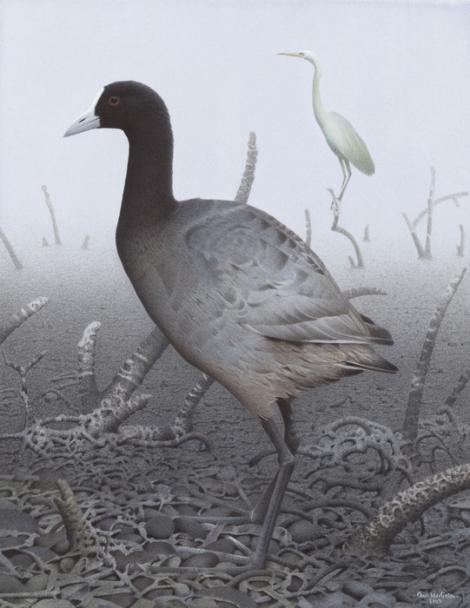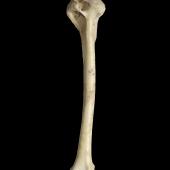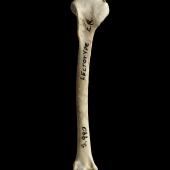New Zealand coot
Fulica prisca Hamilton, 1893
Order: Gruiformes
Family: Rallidae
Geographical variation: Sometimes regarded as a subspecies of Fulica chathamensis
This large, extinct coot was first described from Southland but is now known from many sites in both the South and North Islands. Augustus Hamilton did not designate a holotype, basing the species on a syntype series carrying the letters CR (Castle Rock, Oreti River, the type locality) collected in 1892 and held by Te Papa. Storrs Olson subsequently designated a right humerus as the lectotype (registration number S.990).
The New Zealand coot was about twice the weight of extant coots. Its body proportions were similar to other coots, and so it was probably capable of flight. Unlike other coots, however, the New Zealand coot was more terrestrial and was found at forested inland sites and even subalpine environments in addition to coastal wetlands.
Whether the New Zealand coot was diagnosably distinct from the slightly larger Chatham Island coot has been a matter of debate. Olson separated them as subspecies on the basis of a difference in the humerus, but Phil Millener thought this characteristic was unreliable and suggested that the two subspecies were separable by features of the sternum and tibiotarsus. Trevor Worthy and Richard Holdaway re-examined the fossil material, and recommended that the two be treated as separate species on the basis of cranial shape and proportional differences between various post-cranial skeletal elements.
The New Zealand coot became extinct in prehistoric times due to over-hunting by early Maori. Its bones are common in two archaeological middens in coastal Marlborough, where some coot bones were shaped into tools.
Weblink
References
Gill, B.; Martinson, P. 1991. New Zealand’s extinct birds. Random Century, Auckland.
Millener, P.R. 1980. The taxonomic status of extinct New Zealand coots, Fulica chathamensis subspp. (Aves: Rallidae). Notornis 27: 363-367.
Millener, P.R. 1981. The subfossil distribution of extinct New Zealand coots Fulica chathamensis subspp. (Aves: Rallidae). Notornis 28: 1-9.
Olson, S.L. 1975. A review of the extinct rails of the New Zealand region (Aves: Rallidae). Records of the National Museum of New Zealand, 1: 63-79.
Tennyson, A.; Martinson, P. 2006. Extinct birds of New Zealand. Te Papa Press, Wellington.
Worthy, T.H.; Holdaway, R.N. 2002. The lost world of the moa. Indiana University Press, Bloomington and Indianapolis.
Recommended citation
Michaux, B. 2013 [updated 2017]. New Zealand coot. In Miskelly, C.M. (ed.) New Zealand Birds Online. www.nzbirdsonline.org.nz
New Zealand coot
- Breeding season
-
- Jul
- Aug
- Sep
- Oct
- Nov
- Dec
- Jan
- Feb
- Mar
- Apr
- May
- Jun
- Egg laying dates
-
- Jul
- Aug
- Sep
- Oct
- Nov
- Dec
- Jan
- Feb
- Mar
- Apr
- May
- Jun









